Numerical Analysis on the Influence of Joint Density on the Stability of Complex Jointed Roadway Surrounding Rock
Abstract
:1. Introduction
2. Summary of Engineering Background
3. Calibration and Construction of Parameters for the Complex Jointed Roadway Surrounding Rock Model
3.1. Calibration of Particle Micromechanical Parameters for the Surrounding Rock of the Roadway
3.2. Calibration of Micromechanical Parameters for Joint Surfaces
3.3. Construction of Complex Jointed Roadway Surrounding Rock Model
4. Analysis of the Influence of Joint Density on the Stability of Roadway Surrounding Rock
4.1. Analysis of Displacement Field Variation
- (1)
- With the location closer to the roadway sidewall, the impact of joint density on the deformation of the roadway surrounding rock becomes greater. The displacement values of the roadway roof, floor, and sidewalls are affected differently by joint density. From Figure 13c, it can be observed that as the joint density εf increases from 0 m/m−2 to 0.2 m/m−2, significant deformation first occurs in the sidewall of the roadway. The maximum displacement value of the right sidewall increases from 3 mm to 50 mm, an increase of 47 mm. From Figure 13b, it can be seen that when the joint density εf increases to 0.4 m/m−2, significant deformation subsequently occurs in the floor, with the maximum floor heave increasing to 46 mm. When the joint density εf increases to 1.0 m/m−2, the maximum displacements of the left and right sidewalls, roof, and floor reach 247 mm, 380 mm, 124 mm, and 234 mm, respectively. The convergence of the left and right sidewalls is 627 mm, and the convergence of the roof and floor is 358 mm. The analysis reveals the following reasons: as the roadway is excavated along the roof, both sidewalls and the floor consist of relatively weak coal layers, while the roof consists of mudstone and sandy mudstone. Therefore, the sidewalls and floor are the first to undergo significant deformation due to the influence of joint density, followed by the roof.
- (2)
- As the joint density increases, the main areas of deformation in the roadway surrounding rock extend from the shallow rock mass to the deep rock mass. Taking the deformation of the roadway sidewall as an example, from Figure 13c,d, it can be observed that when the joint density εf increases from 0 m/m−2 to 0.4 m/m−2, the main deformation of the right sidewall occurs at the 0–1.0 m range, while the main deformation of the left sidewall occurs at the 0–1.5 m range. When the joint density εf increases to 0.6 m/m−2, deformation of the surrounding rock starts at a distance of 2.0 m from the right sidewall, and the convergence of the right sidewall increases to 51 mm. When the joint density εf increases to 0.8 m/m−2, deformation of the surrounding rock begins at a distance of 2.0 m from the left sidewall, and the convergence increases to 31 mm. When the joint density εf increases to 1.0 m/m−2, the convergence of the surrounding rock from both sidewalls reaches 78 mm and 72 mm at a distance of 2.0 m from the sidewalls. It can be observed that the increase in joint density leads to a decrease in the overall bearing capacity of the roadway surrounding rock. Shallow rock mass deformation and damage are severe, and the load-bearing rock mass gradually transfers towards the surrounding rock.
4.2. Analysis of Stress Field Variation
- (1)
- During the process of stress redistribution in the roadway surrounding rock, the vertical stress of the roof and floor is released more significantly compared to the horizontal stress, while the horizontal stress of the sidewalls is released more significantly compared to the vertical stress. With the distance closer to the sidewall, the stress release ratio of the surrounding rock becomes greater. Taking the stress of the roof and floor surrounding rock as an example, when the distance from the sidewall is 1.0 m, the vertical stress release rate of the roof and floor are 92% and 98%, respectively, and the horizontal stress release rate are 42% and 46%; when the distance from the sidewall is 5.2 m, the vertical stress release rate of the roof and floor are 44% and 59%, respectively, and the horizontal stress release rate are −18% and −6%. It can be seen that with the increasing depth from the sidewall, the vertical stress of the roof remains in a release state, while the roof and floor show a zone of increased horizontal stress.
- (2)
- The horizontal stress of the roof and floor, as well as the vertical stress and horizontal stress of the sidewalls, gradually change from positive values to negative values, indicating a continuous zone of stress increase for the horizontal stress of the roof, the vertical stress of the sidewalls, and the horizontal stress of the sidewalls with increasing depth from the sidewall. When the distance from the sidewall is approximately 1.6 m, both sidewalls show a zone of increased vertical stress, with stress release ratios reaching −3.7% and −12.1%, respectively. When the distance from the sidewall is approximately 4 m, the surrounding rock shows a zone of increased horizontal stress, with the horizontal stress release rate of the sidewalls being −0.6% and −5.6%, respectively, and the horizontal stress release rate of the roof and floor being −13.6% and −5.5%, respectively.
4.3. Analysis of Force Chain Field Variation
4.4. Analysis of Energy Field Variation
5. Conclusions
- (1)
- As the distance from the sidewall decreases, the influence of joint density on the deformation of the surrounding rock mass increases. However, the displacement of the roadway roof, floor, and sidewalls is affected by joint density to varying degrees, mainly related to the rock’s lithology.
- (2)
- During the process of rock stress redistribution, the vertical stress of the roof and floor undergoes more significant release compared to the horizontal stress, while the horizontal stress of the sidewalls undergoes more significant release compared to the vertical stress. The increase in joint density leads to an increasing rate of stress release in the surrounding rock, causing the load-bearing rock mass to transfer to deeper layers.
- (3)
- The presence of joints weakens the overall bearing capacity of the surrounding rock. With the increase in joint density, the distribution of force chain networks gradually transitions from dense to sparse, and the strong force chain networks decrease. As a result, the overall bearing capacity of the surrounding rock decreases, and the range of deformation and failure of the sidewalls increases.
- (4)
- As the joint density continuously increases, the values of maximum released kinetic energy and residual released kinetic energy become larger. Excavation disturbance leads to increasingly severe damage to the roadway surrounding rock. When the joint density reaches a certain value, the roadway surrounding rock maintains a high energy level in the kinetic energy stability zone, indicating extreme instability in the roadway and the presence of sustainable deformation.
Author Contributions
Funding
Institutional Review Board Statement
Informed Consent Statement
Data Availability Statement
Conflicts of Interest
References
- Cai, M.; Kaiser, P.; Tasaka, Y.; Minami, M. Determination of residual strength parameters of jointed rock masses using the GSI system. Int. J. Rock Mech. Min. Sci. 2007, 44, 247–265. [Google Scholar] [CrossRef]
- Wu, Q.; Kulatilake, P. REV and its properties on fracture system and mechanical properties, and an orthotropic constitutive model for a jointed rock mass in A dam site in China. Comput. Geotech. 2012, 43, 124–142. [Google Scholar] [CrossRef]
- Xu, C.; Dowd, P. A new computer code for discrete fracture network modelling. Comput. Geosci. 2010, 36, 292–301. [Google Scholar] [CrossRef]
- Zhao, Y.; Jiang, L.; Li, C.; Niu, Q.; Sainoki, A.; Mitri, H.; Ning, J. Experimental investigation into the mechanical behavior of jointed soft rock using sand powder 3d printing. Rock Mech. Rock Eng. 2023, 5, 5383–5404. [Google Scholar] [CrossRef]
- Souley, M.; Homang, H. Stability of jointed rock masses evaluated by UDEC with an extended Saeb-Amadei constitutive law. Int. J. Rock Mech. Min. Sci. Geomech. Abstr. 1996, 33, 233–244. [Google Scholar] [CrossRef]
- Souley, M.; Homand, F.; Thoraval, A. The effect of joint constitutive laws on the modelling of an underground excavation and comparison with measurements. Int. J. Rock Mech. Min. Sci. 1997, 34, 97–115. [Google Scholar] [CrossRef]
- Cao, R.; Cao, P.; Fan, X.; Xiong, X.; Lin, H. An Experimental and Numerical Study on Mechanical Behavior of Ubiquitous-Joint Brittle Rock-Like Specimens Under Uniaxial Compression. Rock Mech. Rock Eng. 2016, 49, 4319–4338. [Google Scholar] [CrossRef]
- Yang, X.; Jing, H.; Tang, C.; Yang, S. Effect of parallel joint interaction on mechanical behavior of jointed rock mass models. Int. J. Rock Mech. Min. Sci. 2017, 92, 40–53. [Google Scholar] [CrossRef]
- Liu, Y.; Dai, F.; Dong, L.; Xu, N.; Feng, P. Experimental Investigation on the Fatigue Mechanical Properties of Intermittently Jointed Rock Models Under Cyclic Uniaxial Compression with Different Loading Parameters. Rock Mech. Rock Eng. 2018, 51, 47–68. [Google Scholar] [CrossRef]
- Dou, L.; Yang, K.; Chi, X. Fracture behavior and acoustic emission characteristics of sandstone samples with inclined precracks. Int. J. Coal Sci. Technol. 2021, 8, 77–87. [Google Scholar] [CrossRef]
- Wu, H.; Chen, J.; Gao, X.; Ling, T.; Zhang, X.; Jia, Q. Study on Failure Mechanism and Control Technology of Roadway Surrounding Rock under Complex Occurrence Coal Seam. Geofluids 2022. [CrossRef]
- Ma, K.; Sun, X.; Tang, C.; Wang, S.; Yuan, F.; Peng, Y.; Liu, K. An early warning method for water inrush in Dongjiahe coal mine based on microseismic moment tensor. J. Cent. South Univ. Technol. 2020, 27, 3133–3148. [Google Scholar] [CrossRef]
- Ren, F.; Zhu, C.; He, M.; Shang, J.; Feng, G.; Bai, J. Characteristics and Precursor of Static and Dynamic Triggered Rockburst: Insight from Multifractal. Rock Mech. Rock Eng. 2022, 56, 1945–1967. [Google Scholar] [CrossRef]
- Yang, S.; Yin, P.; Zhang, Y.; Chen, M.; Zhou, X.; Jing, H.; Zhang, Q. Failure behavior and crack evolution mechanism of a non-persistent jointed rock mass containing a circular hole. Int. J. Rock Mech. Min. Sci. 2019, 114, 101–121. [Google Scholar] [CrossRef]
- Wang, F.; Xie, H.; Zhou, C.; Wang, C.; Li, C. Combined effects of fault geometry and roadway cross-section shape on the collapse behaviors of twin roadways: An experimental investigation. Tunn. Undergr. Space Technol. 2023, 137, 105106. [Google Scholar] [CrossRef]
- Guo, Z.; Fan, J.; Wang, F.; Zhou, H.; Li, W. Geomechanical Model Experiment Study on Deformation and Failure Mechanism of the Mountain Roadway in Layered Jointed Rock Mass. Adv. Civ. Eng. 2021. [Google Scholar] [CrossRef]
- Huang, F.; Zhu, H.; Xu, Q.; Cai, Y.; Zhuang, X. The effect of weak interlayer on the failure pattern of rock mass around tunnel—Scaled model tests and numerical analysis. Tunn. Undergr. Space Technol. 2013, 35, 207–218. [Google Scholar] [CrossRef]
- Li, G.; Ma, F.; Guo, J.; Zhao, H. Experimental research on deformation failure process of roadway tunnel in fractured rock mass induced by mining excavation. Environ. Earth Sci. 2022, 81, 243. [Google Scholar] [CrossRef]
- Xiong, X.; Dai, J.; Ouyang, Y.; Shen, P. Experimental analysis of control technology and deformation failure mechanism of inclined coal seam roadway using non-contact DIC technique. Sci. Rep. 2021, 11, 20930. [Google Scholar] [CrossRef]
- Tao, Z.; Zhu, C.; Zheng, X.; Wang, D.; Liu, Y.; He, M.; Wang, Y. Failure mechanisms of soft rock roadways in steeply inclined layered rock formations. Geomatics. Nat. Hazards Risk 2018, 9, 1186–1206. [Google Scholar] [CrossRef]
- Lin, C.; Yu, J.; Chang, F.; Fu, X.; Yao, W.; Cai, Y. Influence of three-dimensional persistent joints on surrounding rock stability of large-span tunnel. J. Cent. South Univ. (Sci. Technol.) 2023, 54, 1141–1152. [Google Scholar]
- He, P.; Li, S.; Li, L.; Zhang, Q.; Xu, F.; Chen, Y. Discontinuous deformation analysis of super section tunnel surrounding rock stability based on joint distribution simulation. Comput. Geotech. 2017, 91, 218–229. [Google Scholar] [CrossRef]
- Jiang, L.; Sainoki, A.; Mitri, H.; Ma, N.; Liu, H.; Hao, Z. Influence of fracture-induced weakening on coal mine gateroad stability. Int. J. Rock Mech. Min. Sci. 2016, 88, 307–317. [Google Scholar] [CrossRef]
- Yang, Z. Characterization of rock joint roughness and study of shear mechanical behavior under confinement. Taiyuan Univ. Technol. 2021. [Google Scholar] [CrossRef]
- Fang, G.; Yang, S.; Sun, J.; Cheng, J. Study on instability fracture evolution of deep thick coal seams based on discrete element simulation. J. Min. Saf. Eng. 2016, 33, 676–683. [Google Scholar]
- Chi, X.; Zhang, Z.; Li, L.; Wang, Q.; Wang, Z.; Dong, H.; Xie, Y. Numerical and Experimental Study on a Novel Filling Support Method for Mining of Closely Spaced Multilayer Orebody. Minerals 2022, 12, 1523. [Google Scholar] [CrossRef]
- Liu, X.; Wang, G.; Wen, Z.; Wang, D.; Song, L.; Lin, M.; Chen, H. The Transient Unloading Response of a Deep-Buried Single Fracture Tunnel Based on the Particle Flow Method. Sustainability 2023, 15, 6840. [Google Scholar] [CrossRef]
- Zhang, D.; Guo, W.; Zhao, T.; Zhao, Y.; Chen, Y.; Zhang, X. Energy Evolution Law during Failure Process of Coal–Rock Combination and Roadway Surrounding Rock. Minerals 2022, 12, 1535. [Google Scholar] [CrossRef]
- Zou, Y.; Li, X.; Zhou, Z.; Yin, T.; Yin, Z. Energy evolution and stress redistribution of high-stress rock mass under excavation distribution. Chin. J. Geotech. Eng. 2012, 34, 1677–1684. [Google Scholar]


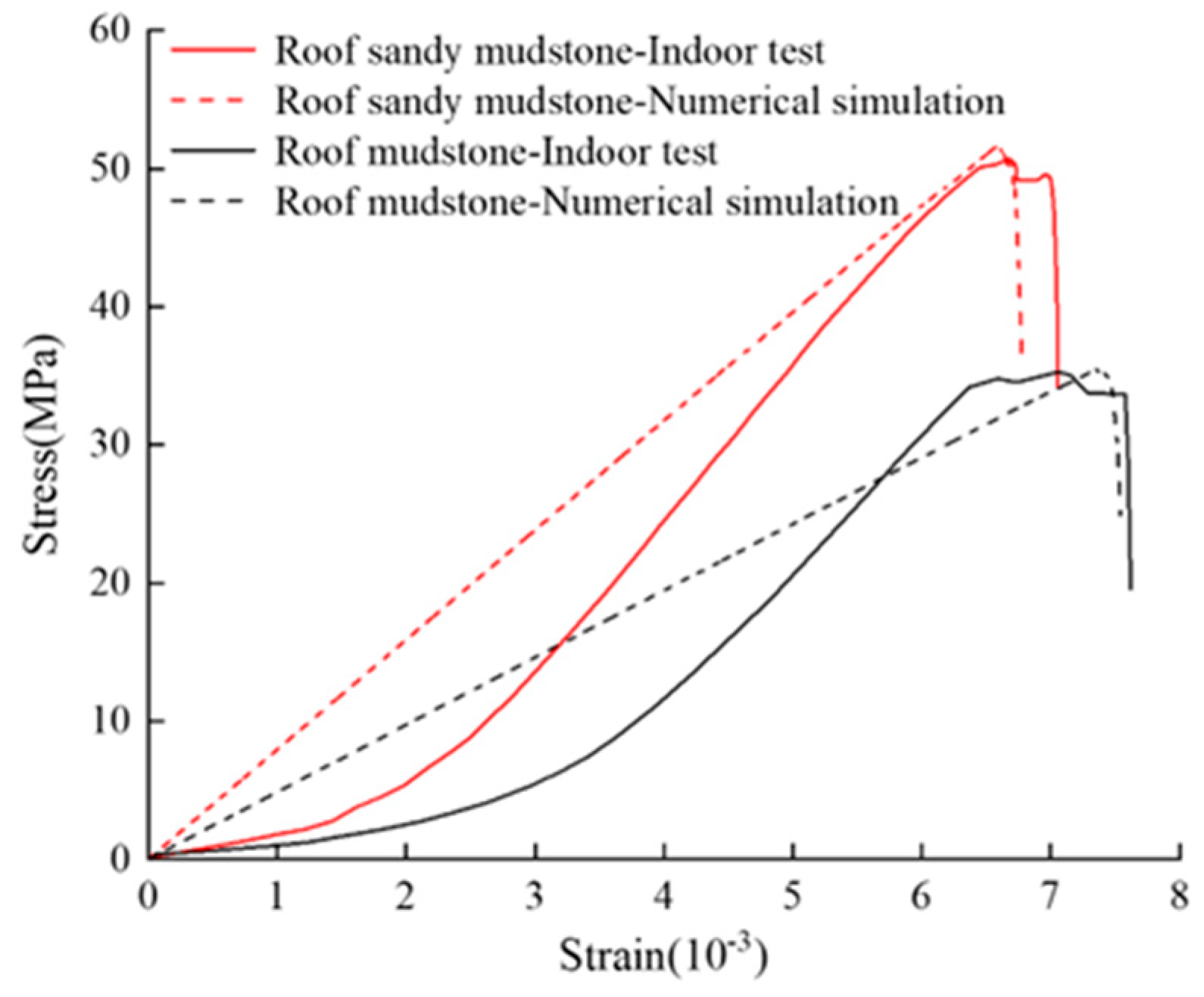


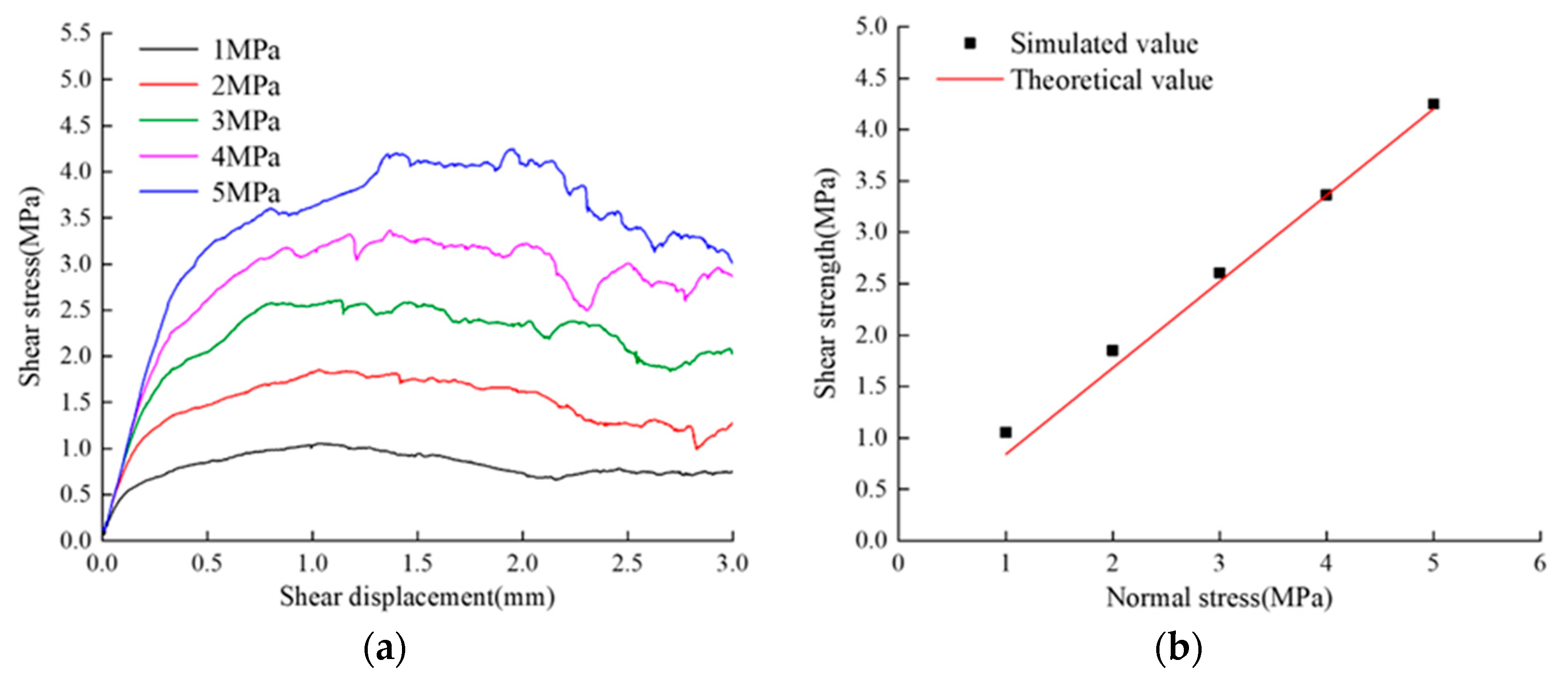

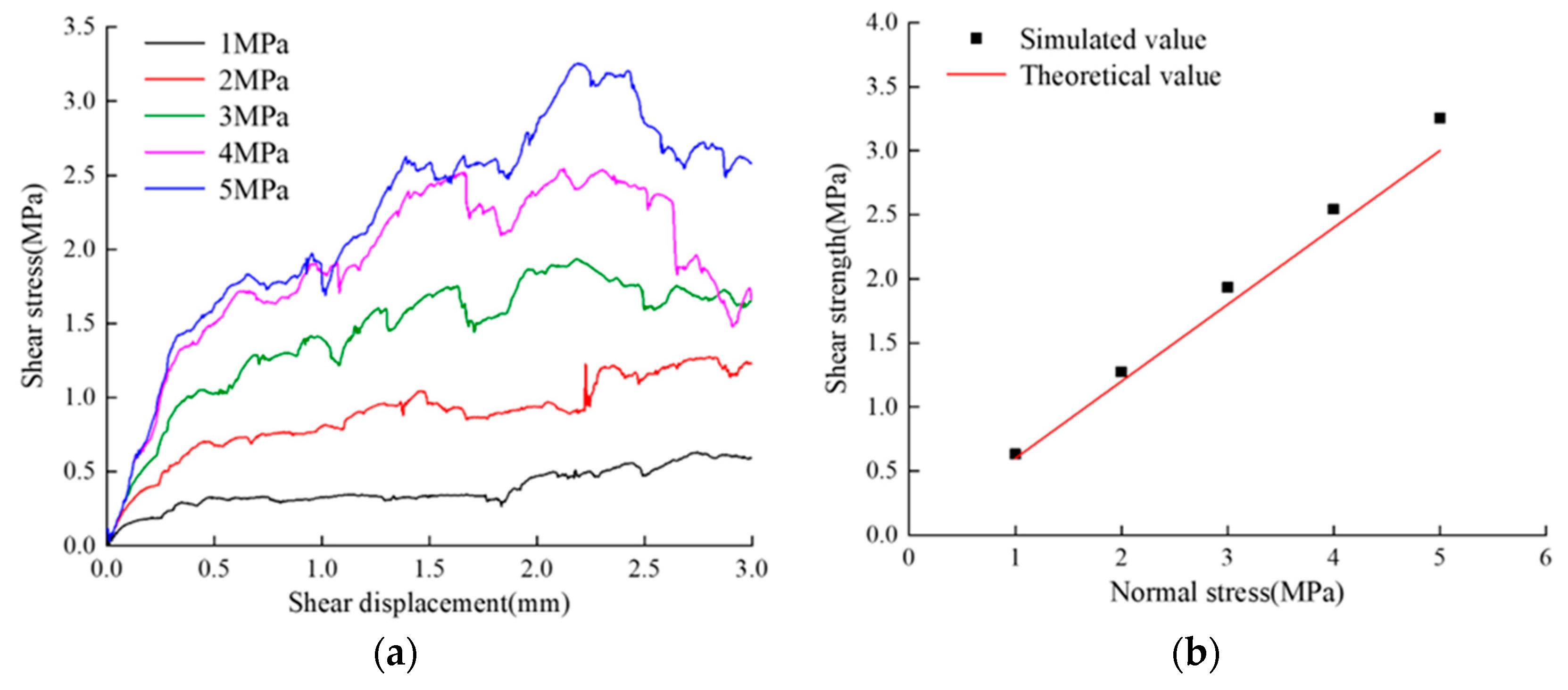
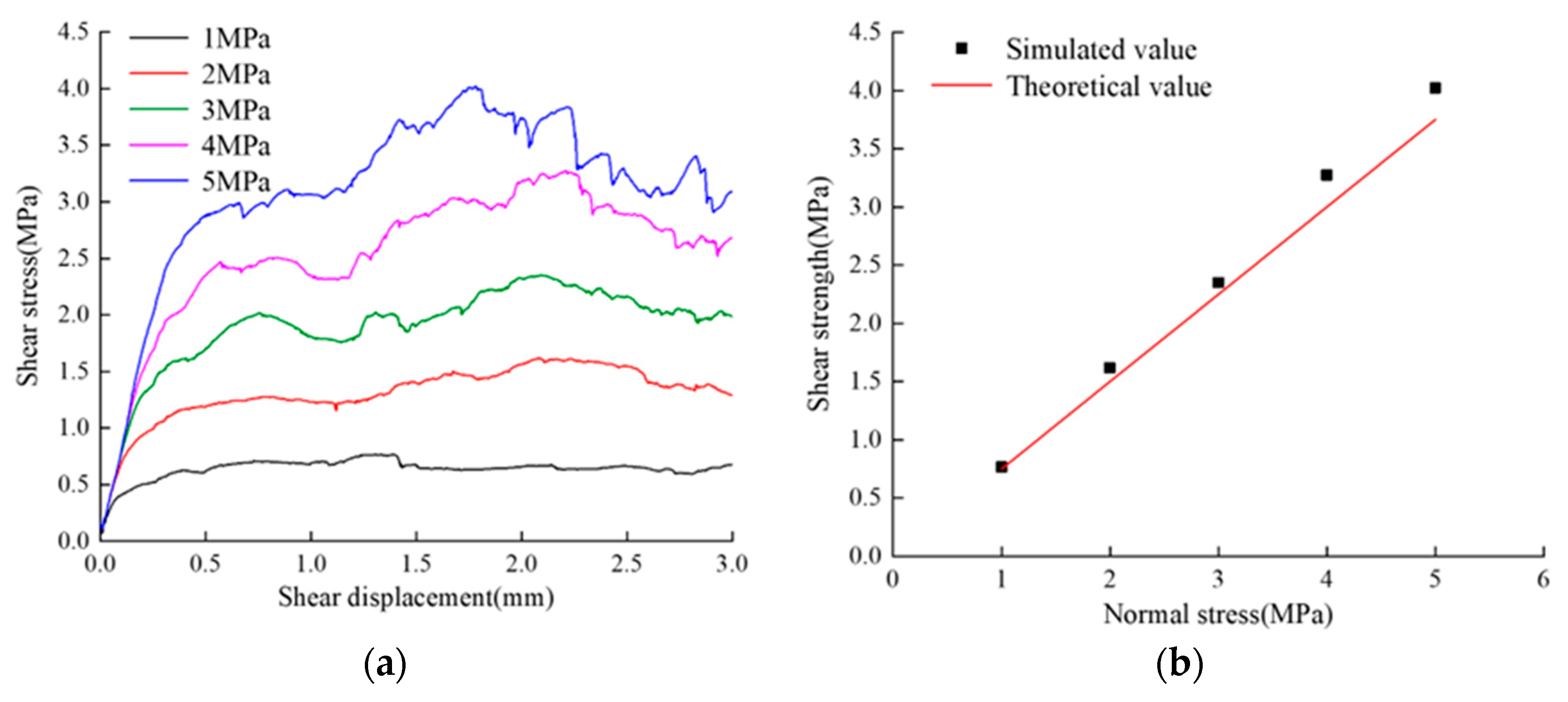
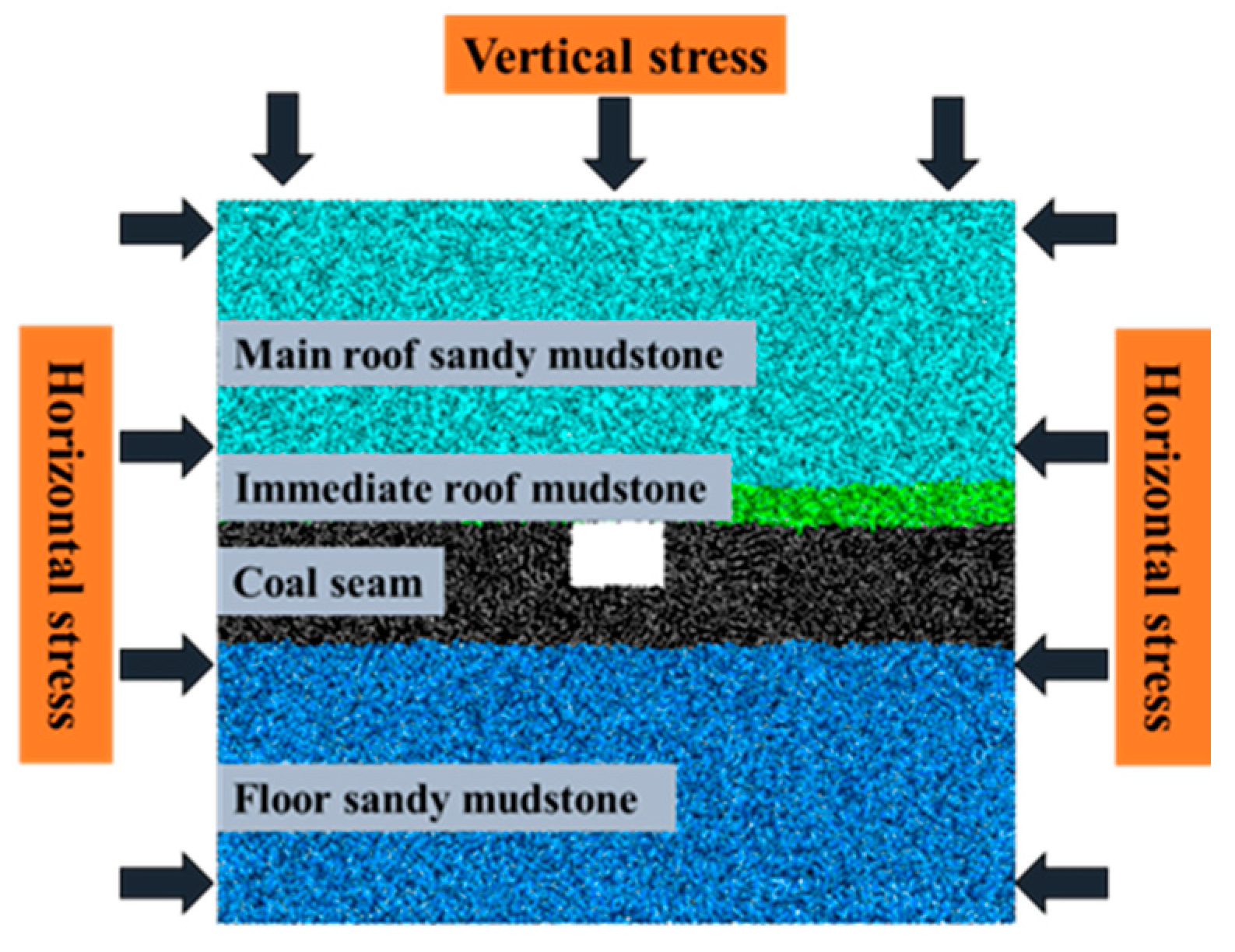

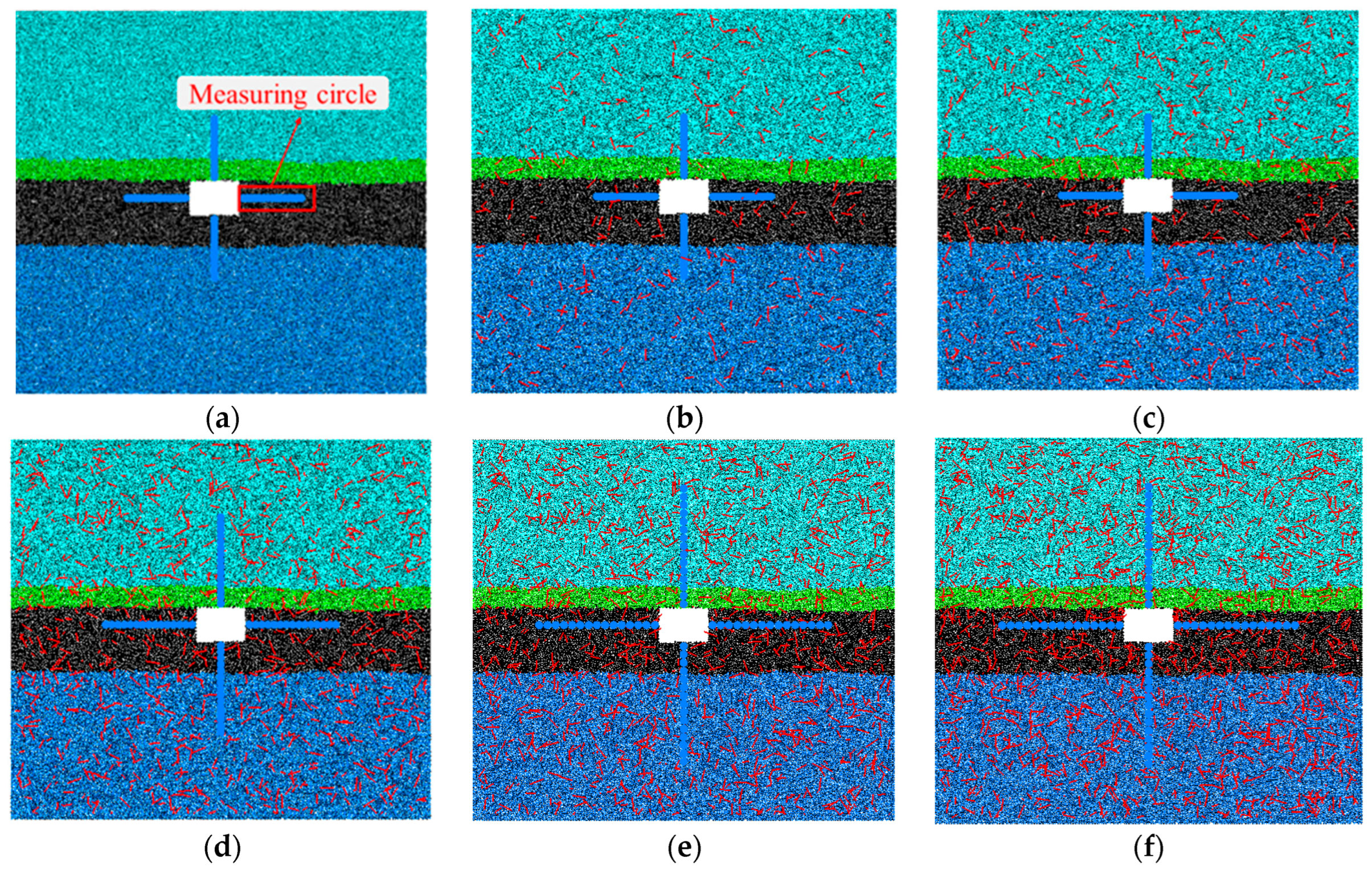
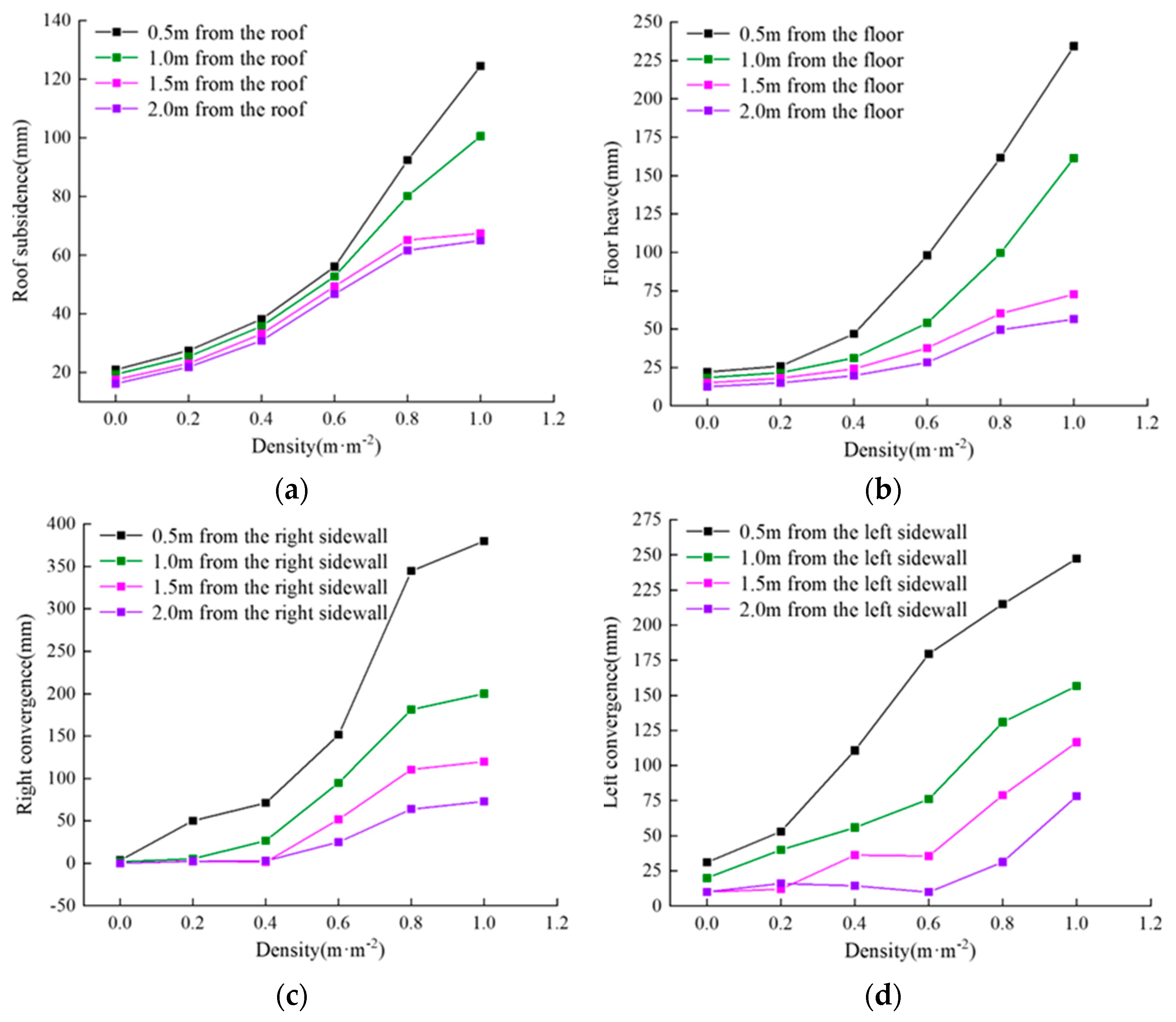

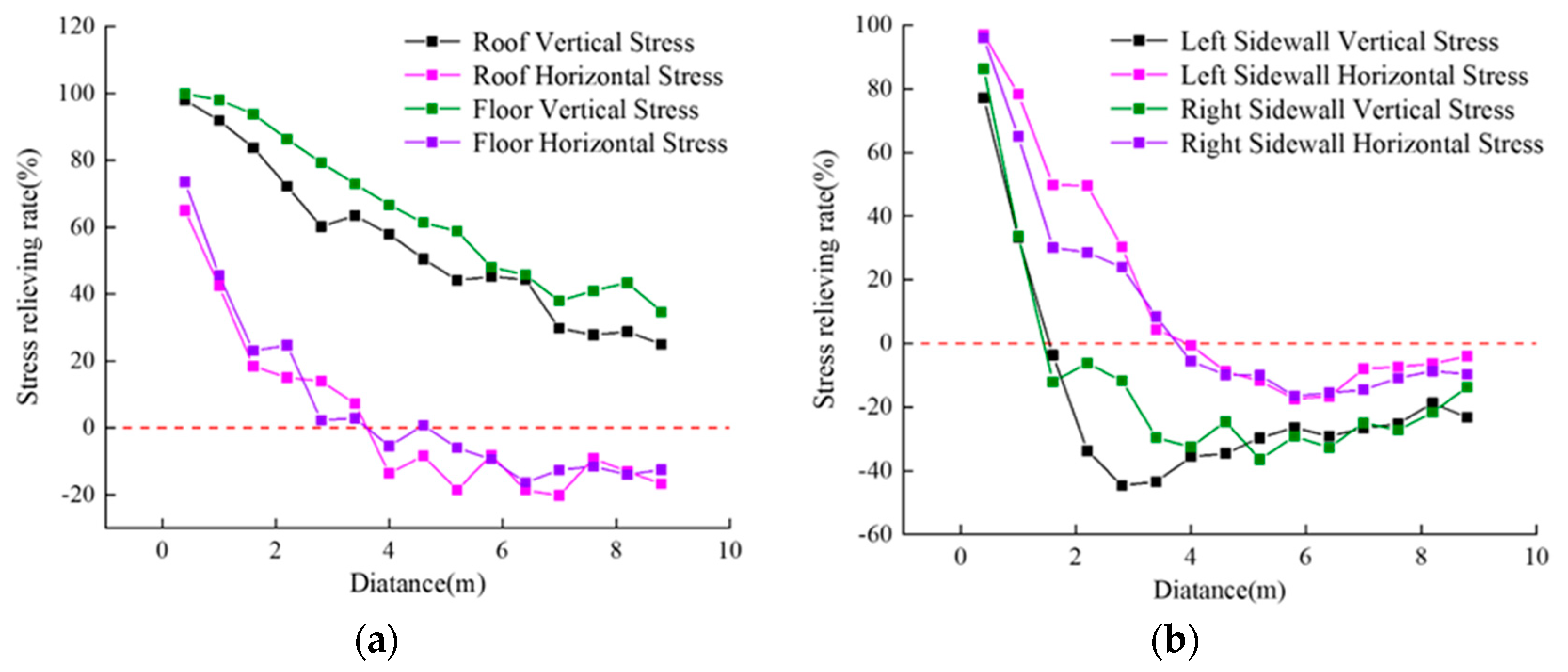



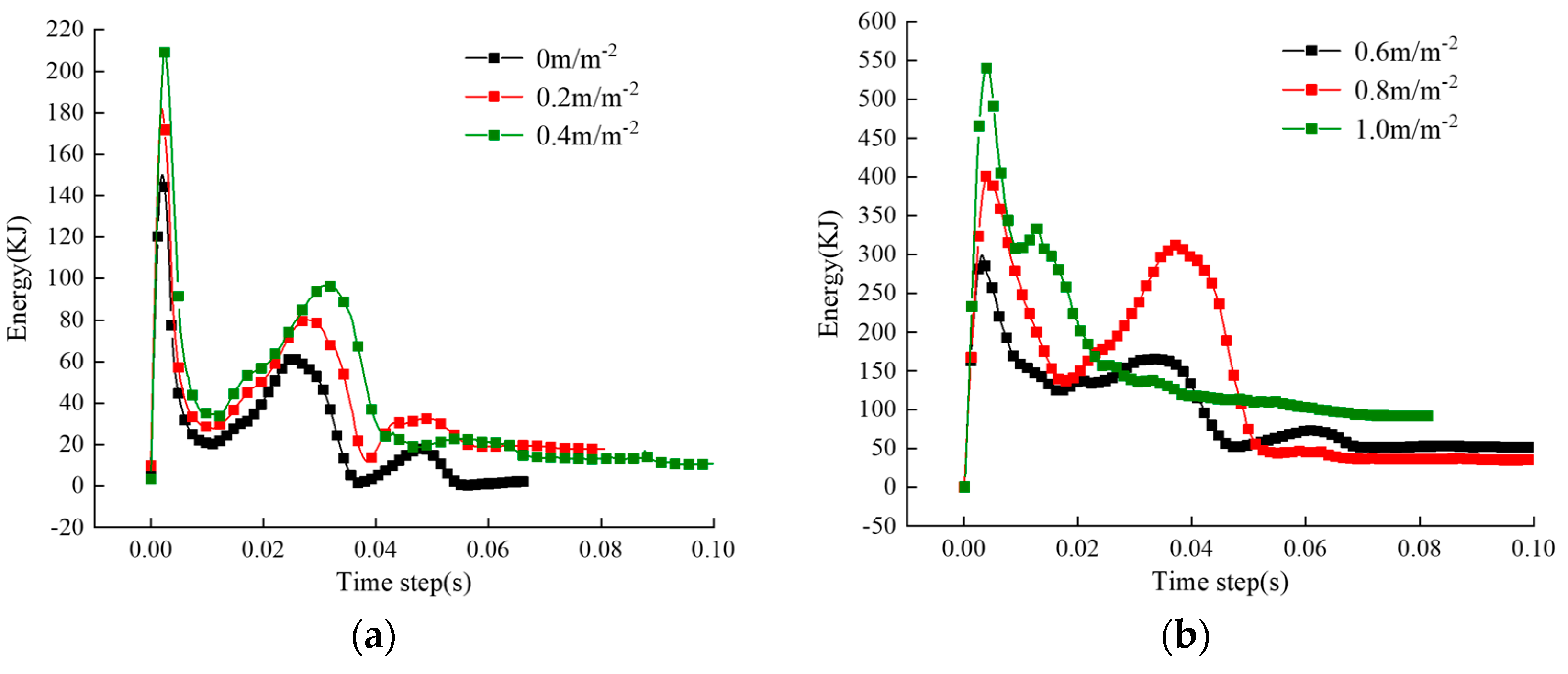
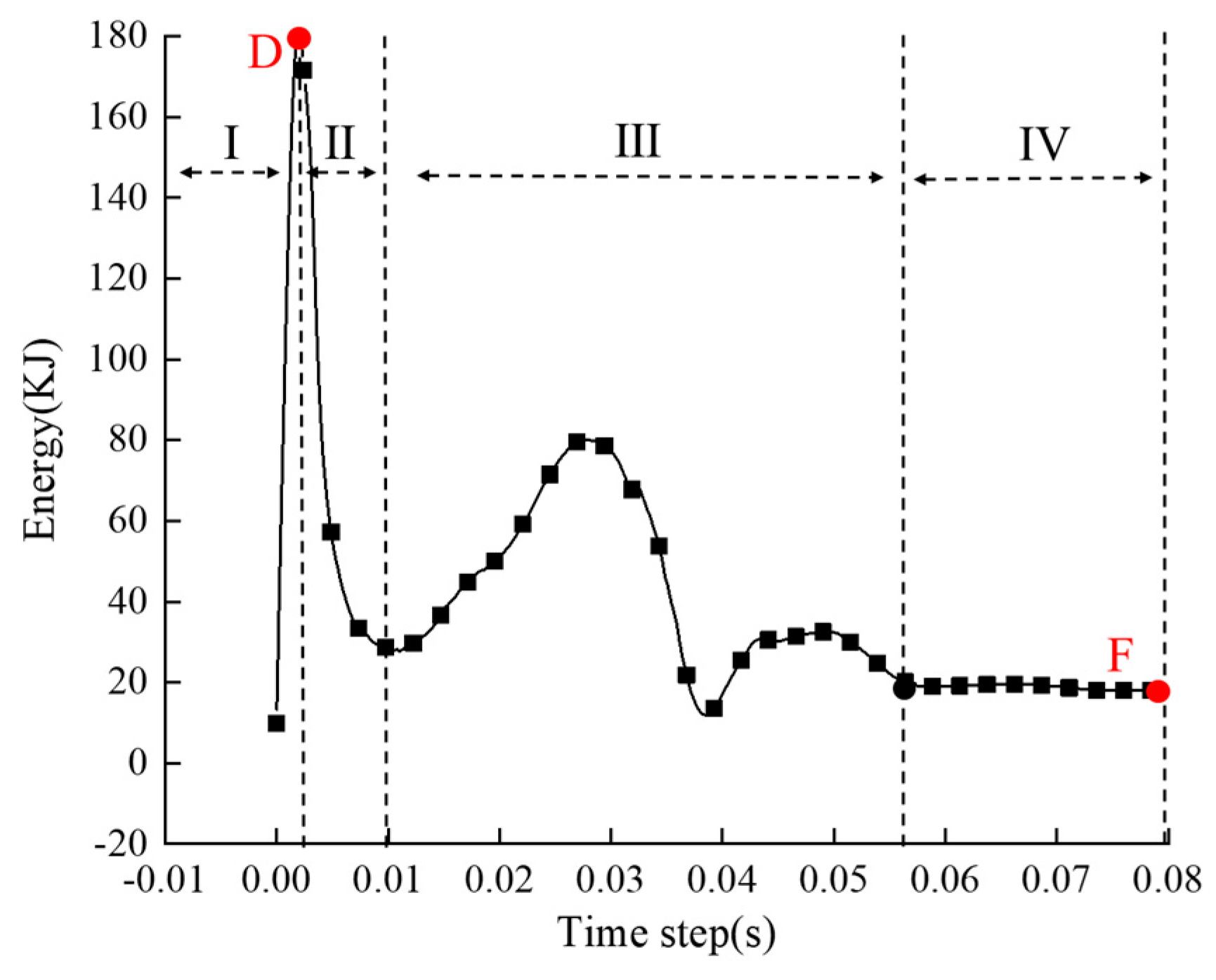
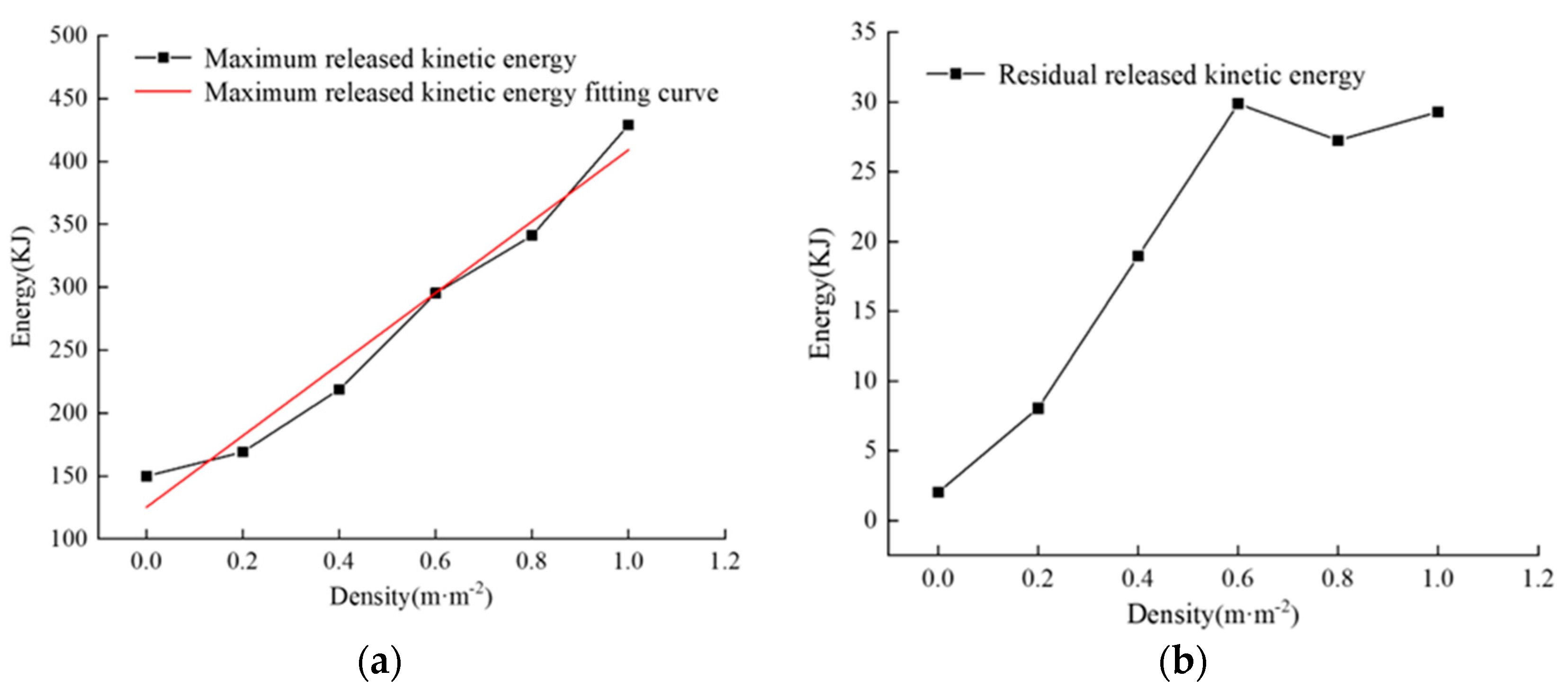
| Minimum Particle Radius Rmin/m | Maximum Particle Radius Rmin/m | Elastic Modulus Εc/GPa | Stiffness Ratio kn/ks | Particle Density ρ/kg·m−3 | Friction Coefficient μ |
|---|---|---|---|---|---|
| 6.0 × 10−2 | 8.0 × 10−2 | 10 | 1.5 | 2700 | 0.7 |
| Linear Parallel Bond Model Parameters | Elastic Modulus Εc/GPa | Stiffness Ratio kn/ks | Friction Coefficient μ | Tensile Strength σc/MPa | Cohesion c/MPa | Friction φ/° |
|---|---|---|---|---|---|---|
| Main roof sandy mudstone | 3.1 | 1.4 | 0.577 | 12.7 | 14.1 | 20 |
| Immediate roof mudstone | 1.9 | 1.4 | 0.577 | 12.5 | 7.2 | 20 |
| Coal–rock | 1.1 | 1.4 | 0.577 | 6.2 | 7.5 | 20 |
| Floor sandy mudstone | 3.2 | 1.4 | 0.577 | 11.0 | 13.0 | 20 |
| Smooth Joint Parameters | Normal Stiffness kn/GPa | Shear Stiffness ks/GPa | Friction Coefficient μ | Tensile Strength ten/MPa | Cohesion c/MPa | Friction Angle φ/° |
|---|---|---|---|---|---|---|
| Main roof sandy mudstone | 0.4 | 0.6 | 0.8 | 0 | 0 | 40 |
| Immediate roof mudstone | 0.4 | 0.1 | 0.8 | 0 | 0 | 35 |
| Coal–rock | 0.4 | 0.1 | 0.13 | 0 | 0 | 31 |
| Floor sandy mudstone | 0.4 | 0.5 | 0.4 | 0 | 0 | 37 |
Disclaimer/Publisher’s Note: The statements, opinions and data contained in all publications are solely those of the individual author(s) and contributor(s) and not of MDPI and/or the editor(s). MDPI and/or the editor(s) disclaim responsibility for any injury to people or property resulting from any ideas, methods, instructions or products referred to in the content. |
© 2023 by the authors. Licensee MDPI, Basel, Switzerland. This article is an open access article distributed under the terms and conditions of the Creative Commons Attribution (CC BY) license (https://creativecommons.org/licenses/by/4.0/).
Share and Cite
Wang, W.; Wu, C.; Yang, Y.; Peng, X.; Jiang, L.; Huang, Y. Numerical Analysis on the Influence of Joint Density on the Stability of Complex Jointed Roadway Surrounding Rock. Sustainability 2023, 15, 13561. https://doi.org/10.3390/su151813561
Wang W, Wu C, Yang Y, Peng X, Jiang L, Huang Y. Numerical Analysis on the Influence of Joint Density on the Stability of Complex Jointed Roadway Surrounding Rock. Sustainability. 2023; 15(18):13561. https://doi.org/10.3390/su151813561
Chicago/Turabian StyleWang, Wenhai, Chaolei Wu, Yiming Yang, Xiaohan Peng, Lishuai Jiang, and Yifeng Huang. 2023. "Numerical Analysis on the Influence of Joint Density on the Stability of Complex Jointed Roadway Surrounding Rock" Sustainability 15, no. 18: 13561. https://doi.org/10.3390/su151813561
APA StyleWang, W., Wu, C., Yang, Y., Peng, X., Jiang, L., & Huang, Y. (2023). Numerical Analysis on the Influence of Joint Density on the Stability of Complex Jointed Roadway Surrounding Rock. Sustainability, 15(18), 13561. https://doi.org/10.3390/su151813561







